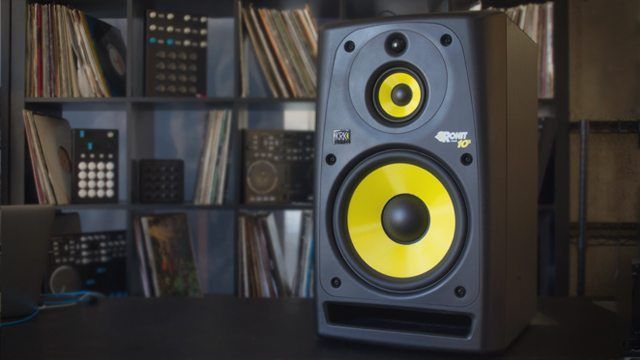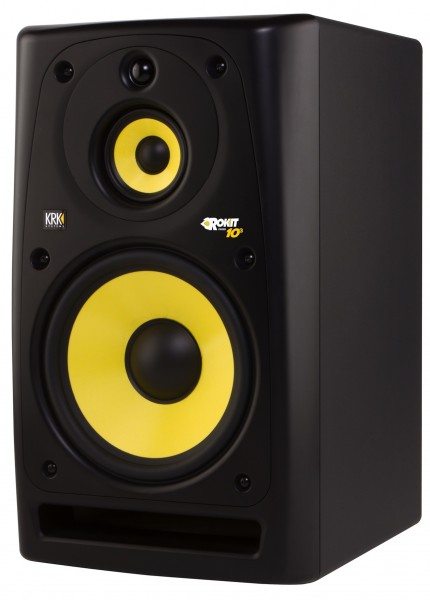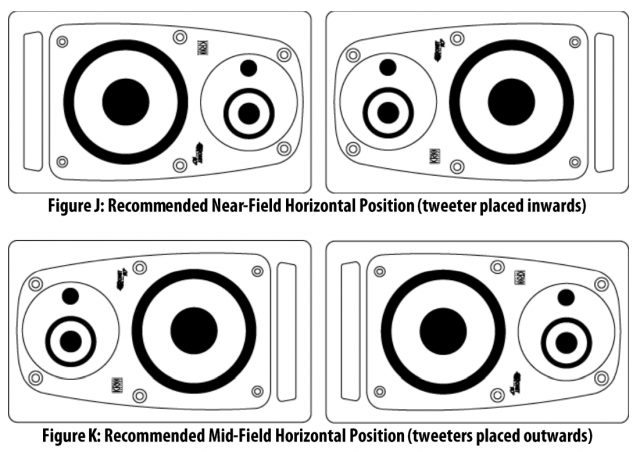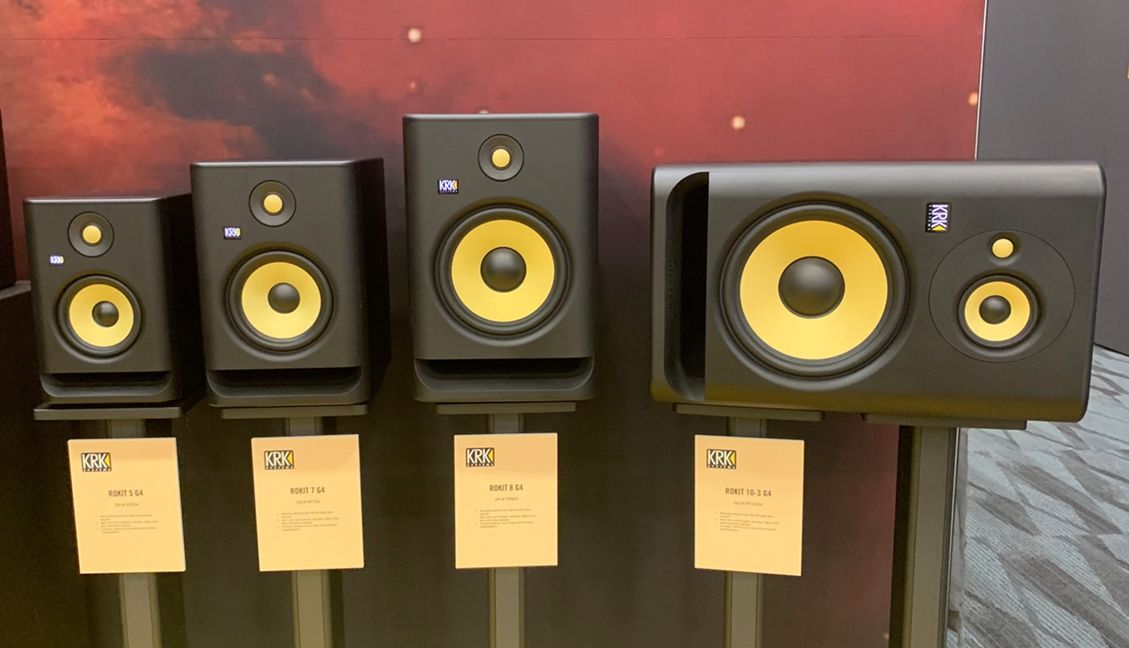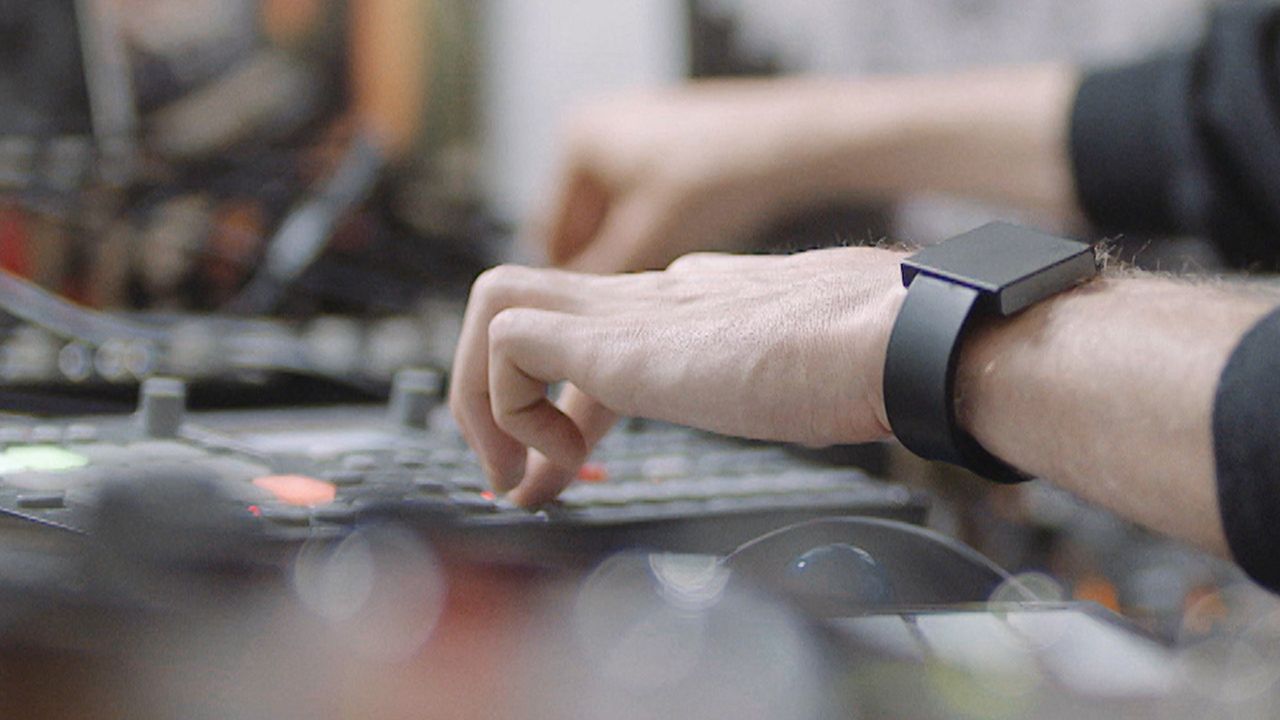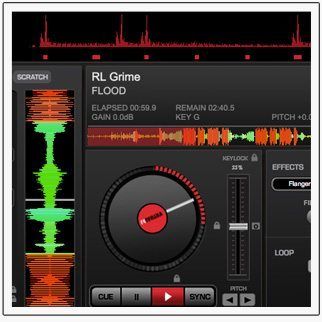KRK has scraped its way toward the top of the crowded studio monitor heap, due in no small part to the trusted Rokit G2 line of mid-priced monitors. Now, the big dog of the family, the tri-amped Rokit 10-3, is looking to have its day. An innovative design and versatile inputs and controls invite a closer look. But do their yellow speaker cones signal caution or pure audio gold?
Manufacturer: KRK Systems
Price: $999.99 each (MSRP) $499.99 each (common retail price)
Availability: Now
Ships with: Standard AC power cable with the appropriate country: US three-prong, EU two-prong, AU big three-prong, etc.
Weight: 46 lbs. each
Dimensions: 21.2″ x 12.7″ x 14.3″ (540mm x 325mm x 365mm)
AC Power Input: Standard cable socket, selectable 110-120V / 220-240V
Audio Input Connectors: Unbalanced RCA, balanced 1/4″ TRS, balanced XLR
Frequency Response: 31Hz – 20kHz
Max Peak Sound Pressure Level: 113dB
Power Output: 140W — 30W high frequency, 30W mid frequency, 80W low frequency
High-Frequency Level Adjustment: -2dB, -1dB, 0, and +1dB settings
Speaker Volume Adjustment: -30dB to +6dB
The Good: Wide sweet spot. Three-way design provides detailed, balanced sound across the frequency range. Lots of inputs – XLR, TRS and RCA. High quality for the price. Plenty of SPL power.
The Bad: Large and heavy. Noisier than lesser-powered KRK Rokit monitors. No input selector switches. Hardcore bass junkies may want to add a subwoofer (KRK makes one: the Rokit 12.)
The Bottom Line: It’s not a beginner’s monitor setup, but if you’re looking to step up in power, versatility, and accurate sound, this jewel of the trusted mid-price Rokit G2 series deserves your consideration.
Clearly, not all speaker and monitor systems are created equal. From large, loud, and accurate monitors to tinny speakers that producers ironically seek out for their similarity to FM radio, monitors come in all varieties, and rating them is bound to involve a certain amount of personal preference.
While new arrivals seem to enter to the monitor market every year, KRK Systems has become one of the go-to names for affordable powered studio monitors, thanks to the Rokit series. Introduced in 2008, the Rokit Powered Generation 2 (G2) series further solidified that reputation.
The latest and largest of KRK’s Rokit G2s, the Rokit Powered 10-3 breaks the mold for the Rokit series, because it is a tri-amped system. This means that high, mid, and low frequencies all get their own speaker, whereas the other Rokits are bi-amped (two speakers) nearfield monitors. The 10-3’s three-way design, along with its size and power, make it suitable for midfield use, although it can be adjusted for nearfield use.
[Nearfield monitors are usually smaller in size and are ideal for a single person sitting in a small sweet spot close to the monitors, three to five feet away. Midfield monitors are larger, usually have three or more amplifiers and provide a larger sweet spot and listening range from five to 13 feet away, suitable for groups of listeners.]
OUT OF BOXY EXPERIENCE
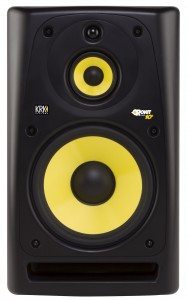 Along with KRK’s signature yellow speaker cones, the Rokit 10-3 comes brandishing an enclosure that features a curved front baffle and curved edges that do more than just look stylish. KRK claims that rectangular monitor cabinets reflect sound coming out of the speaker back into the sound field at different time intervals, resulting in phase distortion that diffuses the sound and narrows the sweet spot. The Rokit G2s are designed to reduce or eliminate that diffraction and provide a wider sweet spot.
Along with KRK’s signature yellow speaker cones, the Rokit 10-3 comes brandishing an enclosure that features a curved front baffle and curved edges that do more than just look stylish. KRK claims that rectangular monitor cabinets reflect sound coming out of the speaker back into the sound field at different time intervals, resulting in phase distortion that diffuses the sound and narrows the sweet spot. The Rokit G2s are designed to reduce or eliminate that diffraction and provide a wider sweet spot.
From the top down, a 1-inch neodymium silk soft dome tweeter handles the high frequencies, and the mid-range driver is a 4-inch aramid glass composite cone. Both of those are powered to 30W each. The 10-inch aramid glass composite cone for the woofer powers the low end with 80W, for a total output of 140W per monitor.
Another signature design trait of the Rokit G2 series is the almost rectangular front firing bass port at the bottom of the monitor. Whereas some monitors have rear ports, this front-firing port is intended to reduce bass coupling with walls and corners that can amplify low frequencies and affect the audio mix.
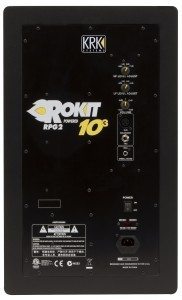 The Rokit 10-3s draw power from a standard three-pronged power cable (included), and there’s a voltage selector on the back to toggle between 110-120V and 220-240V. Flick on the power switch in the back, and the KRK logo on the front illuminates with a satisfying soft glow — a cheap thrill for the studio-tanned gear geek. If the logo is illuminated red, then a fault condition is present and must be solved.
The Rokit 10-3s draw power from a standard three-pronged power cable (included), and there’s a voltage selector on the back to toggle between 110-120V and 220-240V. Flick on the power switch in the back, and the KRK logo on the front illuminates with a satisfying soft glow — a cheap thrill for the studio-tanned gear geek. If the logo is illuminated red, then a fault condition is present and must be solved.
Two back-panel controls are intended to give you some frequency-response options for your particular room acoustics. These include the HF Level Adjust, a 4-position rotary that shelves frequencies above 2kHz by -2dB, -1dB, 0dB (flat), or +1dB. The LF Level Adjust is also a 4-position rotary that shelves or boosts low frequencies by -2dB, -1dB, 0dB (flat), or +2dB. The graphic below from the 10-3 manual shows the frequency effects from the LF and HF Level Adjusts.
On the back there is also a notched volume encoder with a range of -30dB to +6dB, with 0dB sitting at the 12 o’ clock position. I definitely appreciated having a notched volume control, because it was easy to make the same adjustments to both monitors from the front, without even looking at the volume control.
Three analog inputs suit just about any setup: unbalanced RCA, balanced 1/4″ TRS and balanced XLR.
The monitors have a 1/4-inch foam pad on the bottom to cushion them against flat surfaces, they can be positioned horizontally, as well. If placing them horizontally, you need to rotate the tweeter and mid-range driver by removing the front baffle and then rotating the sub-baffle containing the tweeter and mid-range driver. The process requires removing 10 total hex screws and Phillips screws and only takes a few minutes to complete.
The way you should lay the speakers horizontally depends on whether you want to use the 10-3 montitors as nearfield (tweeters placed inward) or mid-field (tweeters placed outward). See the accompanying graphic for an illustration.
PERFORMANCE
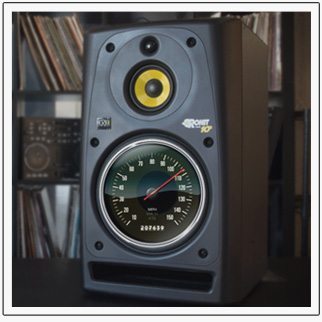 Most, if not all, speakers and monitors emit some amount of hiss/noise even when they’re properly grounded and being fed clean power. When the Rokit 10-3’s powered on, they’re noisier than the KRK Rokit 6 monitors that I also use, which have a barely noticeable noise. But the Rokit 6’s have a total power output of 68W, compared to the 10-3’s 140W, so it stands to reason that 10-3’s would be noisier. Turning any of the back-panel controls up increases the noise level somewhat.
Most, if not all, speakers and monitors emit some amount of hiss/noise even when they’re properly grounded and being fed clean power. When the Rokit 10-3’s powered on, they’re noisier than the KRK Rokit 6 monitors that I also use, which have a barely noticeable noise. But the Rokit 6’s have a total power output of 68W, compared to the 10-3’s 140W, so it stands to reason that 10-3’s would be noisier. Turning any of the back-panel controls up increases the noise level somewhat.
All-in-all, however, the noise is masked as soon as you play some music at anything but the lowest possible volumes, so this standing hiss is not a big deal in my opinion. If you’re not going to crank these up to at least a moderate volume, you should get a smaller pair, anyway.
Besides the smaller pair of Rokit 6’s, I compared the Rokit 10-3’s to a pair of Event 20/20 BAS powered monitors and a Blue Sky MediaDesk 2.1 subwoofer system. In comparison, KRK’s claims of a wider sweet spot were quickly confirmed. I could swing my office chair from side to side within my home studio and still feel like I was hearing an accurate mix. The ideal position, however, was still clearly in the centered sweet spot.
While other companies’ monitors have a tendency to color the sound — the Events with a bright sheen on the high end and the Blue Sky sub system excelling in bass — the Rokit 10-3s presented a pleasant, even-keeled sound that I could listen to pretty much all day without feeling ear fatigue. With a dedicated 10-inch cone driving the low-end, they were bassier than many non-subwoofer monitors I’ve come across, yet that bassiness did not get in the way of the other frequencies.
I experienced excellent stereo imaging and frequency separation across the 10-3’s tri-amped output, even when pumping the bassiest dubstep, hip-hop and tech house I could throw at it. Truly addicted bassaholics may still want to add a subwoofer, however, as the Rokit 10-3 goal is still frequency range accuracy, rather than face-melting thump.
Monitoring my own music, I felt confident that I was getting an accurate representation from the 10-3’s, and my tests listening to reference CDs, as well as Blu-ray movies and big-budget Playstation 3 games, bore out that feeling. The KRKs gave me crisp, accurate details across the frequency spectrum and what I judged to be a transparent mix between the lows, mids, and highs.
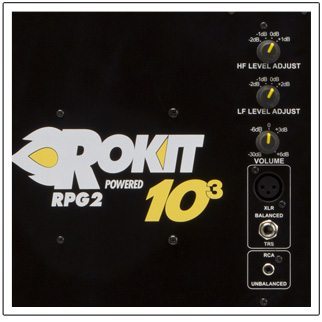 While I prefer to connect to monitors through XLR cables, when possible, the Rokit 10-3’s versatile triple analog inputs came in very handy, especially for DJ systems that only have RCA outputs. I was happy with each of the three analog input types, and just like with the Rokit 6’s, I used the monitors for so many different things that I really wished they had an input selector switch to toggle between active sound sources.
While I prefer to connect to monitors through XLR cables, when possible, the Rokit 10-3’s versatile triple analog inputs came in very handy, especially for DJ systems that only have RCA outputs. I was happy with each of the three analog input types, and just like with the Rokit 6’s, I used the monitors for so many different things that I really wished they had an input selector switch to toggle between active sound sources.
One look at the Rokit 10-3’s should give you some idea that these are about spitting out some sick volume. The maximum SPLs of 113dB are more than enough to abuse your tympanic membranes, and I didn’t even approach the maximum before I was convinced of the 10-3’s ability to at least mimic the kind of volumes you’ll find in a club.
I tested the 10-3’s with several soundcards, including the M-Audio Conectiv, Native Instruments Traktor Audio 10, and Stanton DJC.4. With my DAW or DJ software at half output, the soundcards at half output, and the 10-3’s volume set at 0dB, the 10-3’s loudness broke my personal pain threshold, with plenty of headroom to go louder. Even with the monitors’ volume cranked down to 9 o’ clock, the room was still booming. I really appreciate having plenty of headroom across the entire signal chain and still having more than enough volume.
To me, the even better advantage to the tri-amped Rokit 10-3’s was not the available power, but rather the consistent accuracy of the output regardless of the volume level. The sound stayed consistent whether monitoring at the lowest of levels or at ear-splitting loudness. The three separate speakers really did a remarkable job of sending out reliably transparent sound regardless of volume.
YELLOW FEVER
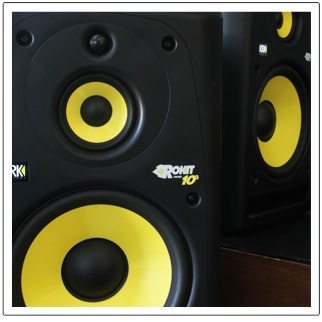 With its detailed reproductions, wide sweet spot, multiple inputs, ear-friendly sound, and mean output levels, the KRK Rokit 10-3 monitors stand out as a respectable option for anyone with the swagger to really warrant them. Small studio or bedroom/basement DJs probably don’t really need this much oomph, unless you plan on rocking frequent house parties with them as well. But if you’ve got a larger room you work in, and especially if you’re producing with guest vocalists or musicians, you might benefit from a pair.
With its detailed reproductions, wide sweet spot, multiple inputs, ear-friendly sound, and mean output levels, the KRK Rokit 10-3 monitors stand out as a respectable option for anyone with the swagger to really warrant them. Small studio or bedroom/basement DJs probably don’t really need this much oomph, unless you plan on rocking frequent house parties with them as well. But if you’ve got a larger room you work in, and especially if you’re producing with guest vocalists or musicians, you might benefit from a pair.
KRK makes a pretty solid case that if you’d rather not get several sets of monitors for different uses like larger studios do, the Rokit 10-3’s make a good jack-of-all-trades system. Their versatile nearfield/mid-field adjustment, as well as consistent and accurate sound across all volumes help prove that point.
You’ll spend about $1000US for a pair, but compared to similarly-priced monitors of this type it’s a pretty solid value. Although there always seems to be a new player who wants to throw their hat into the monitor ring and compete for the most bargain-basement price, KRK is still a trusted source for affordable powered monitors for good reasons.
Think you’ll pick up a set of these? Interested in seeing them in the DJTT webstore? Let us know in the comments below.
Also, you can follow Markkus on Twitter!


